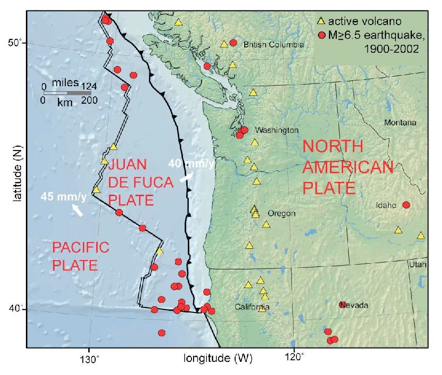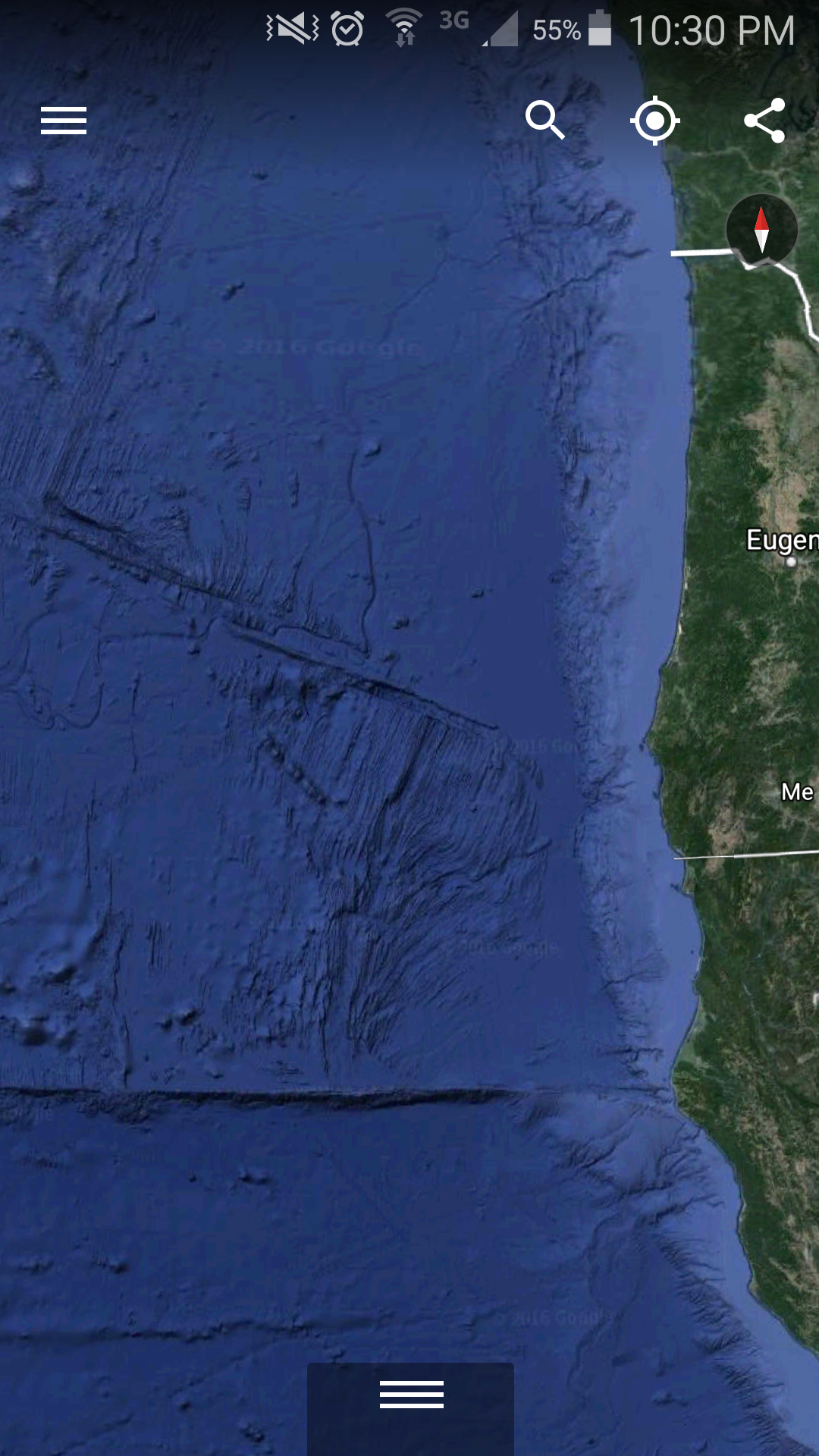It looks like you're using an Ad Blocker.
Please white-list or disable AboveTopSecret.com in your ad-blocking tool.
Thank you.
Some features of ATS will be disabled while you continue to use an ad-blocker.
14
share:
Some information on this seismic zone, the Juan De Fuca. For anyone living in the Pacific Northwest it is always good to know about this plate and
it's past, as it indicates activity in the future.
The subducting crust material also creates magma chambers and uplift in the Northwestern United States, thus the Cascade volcanoes.

As you can see, the zig zag shaped plate is moving under the North American plate. This plate, similar to the one off the coast of Chile and Japan, is capable of producing 9.0+ earthquakes. Subsequent tsunami's with waves in excess of 100 feet have been reported from the area in the past. In fact, the plate has been eerily silent since its last major activity in 1700.
So, we have a long over due megathrust fault line sitting off the northwest coast, however, there was a bit of activity in 2008.
Not only is the plate most likely built up for a major megathrust quake, but it also apparently exhibited unusual seismic activity fairly recently (2008).
Courtesy of Google Earth, we can take an even closer look at this plate via ocean floor mapping.

Quite something, isn't it?
To anyone living in the Pacific Northwest, it is imperative that you have earthquake supplies. Better to be safe than sorry, right?
Redcross has a great set of information on earthquake preparedness here. I'd you'be never taken the time to due so, or your memory is fuzzy on it, it never hurts.
Earthquake preparedness
Hope this helps some folks, and provided some decent information on this seismic region.
The Juan de Fuca Plate is a tectonic plate generated from the Juan de Fuca Ridge and is subducting under the northerly portion of the western side of the North American Plate at the Cascadia subduction zone. It is named after the explorer of the same name. One of the smallest of Earth's tectonic plates, the Juan de Fuca Plate is a remnant part of the once-vast Farallon Plate, which is now largely subducted underneath the North American Plate.
The subducting crust material also creates magma chambers and uplift in the Northwestern United States, thus the Cascade volcanoes.

As you can see, the zig zag shaped plate is moving under the North American plate. This plate, similar to the one off the coast of Chile and Japan, is capable of producing 9.0+ earthquakes. Subsequent tsunami's with waves in excess of 100 feet have been reported from the area in the past. In fact, the plate has been eerily silent since its last major activity in 1700.
The last megathrust earthquake at the Cascadia subduction zone was the 1700 Cascadia earthquake, estimated to have a moment magnitude of 8.7 to 9.2. Based on carbon dating of local tsunami deposits, it occurred around 1700. As reported in National Geographic on 8 December 2003, Japanese records indicate the quake caused a tsunami in Japan, which occurred on 26 January 1700.
So, we have a long over due megathrust fault line sitting off the northwest coast, however, there was a bit of activity in 2008.
In 2008, small earthquakes were observed within the plate. The unusual quakes were described as "more than 600 quakes over the past 10 days in a basin 150 miles southwest of Newport". The quakes were unlike most quakes in that they did not follow the pattern of a large quake, followed by smaller aftershocks; rather, they were simply a continual deluge of small quakes. Furthermore, they did not occur on the tectonic plate boundary, but rather in the middle of the plate. The subterranean quakes were heard on hydrophones, and scientists described the sounds as similar to thunder, and unlike anything heard previously.[2]
Not only is the plate most likely built up for a major megathrust quake, but it also apparently exhibited unusual seismic activity fairly recently (2008).
Courtesy of Google Earth, we can take an even closer look at this plate via ocean floor mapping.

Quite something, isn't it?
To anyone living in the Pacific Northwest, it is imperative that you have earthquake supplies. Better to be safe than sorry, right?
Redcross has a great set of information on earthquake preparedness here. I'd you'be never taken the time to due so, or your memory is fuzzy on it, it never hurts.
Earthquake preparedness
Hope this helps some folks, and provided some decent information on this seismic region.
edit on 21-4-2016 by OneGoal because: (no reason given)
a reply to: OneGoal
What makes us believe that it is "long overdue"? 300 years is not a geologically significant period of time.
Whats the average periodicity between major events?
And how does a few rumbles almost 10 and 15 years ago make it "built up" for a major megathrust quake?
I'm not saying it isn't, I'm no geologist. But it's information that should be included in the OP.
What makes us believe that it is "long overdue"? 300 years is not a geologically significant period of time.
Whats the average periodicity between major events?
And how does a few rumbles almost 10 and 15 years ago make it "built up" for a major megathrust quake?
I'm not saying it isn't, I'm no geologist. But it's information that should be included in the OP.
originally posted by: watchitburn
a reply to: OneGoal
What makes us believe that it is "long overdue"? 300 years is not a geologically significant period of time.
Whats the average periodicity between major events?
And how does a few rumbles almost 10 and 15 years ago make it "built up" for a major megathrust quake?
I'm not saying it isn't, I'm no geologist. But it's information that should be included in the OP.
Scientists are still studying this fault. The periodicity is estimated however between 100-500 years ...
Scientists believe the most recent subduction zone earthquake, a M9 event, occurred in January 1700. The best available evidence indicates that these earthquakes occur, on average, every 500 to 600 years. However, the years between these events have been as few as 100 to 300 years -- meaning, all Cascadia residents should prepare to experience a powerful and potentially damaging subduction zone earthquake in their lifetimes.
So it is right in the middle of the estimated major event time period. Perhaps not long overdue I apologize for any misconstrued notions, however, it very well could be overdue at this point
Hope this helps.
edit on 21-4-2016 by OneGoal because: (no reason given)
a reply to: OneGoal
Researchers do allude to it being long overdue, can happen any time, etc. Here's hopes to they are wrong on this one but never hurts to be prepared even if you're in a pretty safe place. After the very hyped New Yorker article about the fault, recent findings in other articles discussed on how the area is severely non prepared, especially in the city areas.
Some sources:
"Get ready to rumble: A guide to earthquake preparedness"
SeattleTimes
Info and graphics
"Highway Evacuations in Selected Metropolitan Areas: Assessment of Impediments"
Source
Depending on area/neighborhood some of the local papers have pages about preparedness, evacuation and more for your specific location.
"Is America ready for a TSUNAMI? Scientists reveal plans to deal with killer waves across the Pacific Northwest"
Source
Researchers do allude to it being long overdue, can happen any time, etc. Here's hopes to they are wrong on this one but never hurts to be prepared even if you're in a pretty safe place. After the very hyped New Yorker article about the fault, recent findings in other articles discussed on how the area is severely non prepared, especially in the city areas.
Some sources:
"Get ready to rumble: A guide to earthquake preparedness"
SeattleTimes
Info and graphics
"Highway Evacuations in Selected Metropolitan Areas: Assessment of Impediments"
Source
Depending on area/neighborhood some of the local papers have pages about preparedness, evacuation and more for your specific location.
"Is America ready for a TSUNAMI? Scientists reveal plans to deal with killer waves across the Pacific Northwest"
Plans for managing tsunami risk on the West Coast are still evolving, according scientists speaking at the Seismological Society of America's (SSA) 2016 Annual Meeting, held April 20-22 in Reno, Nevada. k
Source
edit on 22-4-2016 by dreamingawake because: (no reason given)
a reply to: dreamingawake
Great information thank you dreaming. Yes it is important that the folks there know of the importance of readiness for this type of event. Could happen in their lifetimes.
Great information thank you dreaming. Yes it is important that the folks there know of the importance of readiness for this type of event. Could happen in their lifetimes.
new topics
-
New Disney Star Wars Films Failing Test of Time?
Movies: 2 hours ago -
The Cost of True Discipleship—Count the Cost
Religion, Faith, And Theology: 7 hours ago -
population madness
New World Order: 8 hours ago -
Mass UAP events. DC. Machester Airport, UFOs over sub base in CT, Nuke bases.
Aliens and UFOs: 9 hours ago
top topics
-
Unidentified Flying Objects Over U.S. Military Bases in Northeast UK, as of roughly 11 a.m. CST.
Aliens and UFOs: 13 hours ago, 11 flags -
Mass UAP events. DC. Machester Airport, UFOs over sub base in CT, Nuke bases.
Aliens and UFOs: 9 hours ago, 7 flags -
Thanking a rosemary plant
General Chit Chat: 13 hours ago, 6 flags -
Holy Cow! Erm...Six Legged Turkey!!
World Sports: 17 hours ago, 2 flags -
population madness
New World Order: 8 hours ago, 2 flags -
The Cost of True Discipleship—Count the Cost
Religion, Faith, And Theology: 7 hours ago, 0 flags -
New Disney Star Wars Films Failing Test of Time?
Movies: 2 hours ago, 0 flags
active topics
-
New Disney Star Wars Films Failing Test of Time?
Movies • 4 • : Lazy88 -
Of all things, grunge music. Short, simple, relevant, not NSFW.
Conspiracies in Religions • 47 • : Solvedit -
Post A Funny (T&C Friendly) Pic Part IV: The LOL awakens!
General Chit Chat • 7846 • : PinkFreud -
V.P. Kamala Harris releases a video and nobody understands why
US Political Madness • 98 • : WeMustCare -
Unidentified Flying Objects Over U.S. Military Bases in Northeast UK, as of roughly 11 a.m. CST.
Aliens and UFOs • 27 • : onestonemonkey -
population madness
New World Order • 14 • : Xtrozero -
Holy Cow! Erm...Six Legged Turkey!!
World Sports • 7 • : Flyingclaydisk -
Thanking a rosemary plant
General Chit Chat • 5 • : Daniidoom -
Results of the use of the Oreshnik missile system in Dnepropetrovsk
World War Three • 246 • : Dandandat3 -
Vladimir Putin's speech at the meeting of the CSTO Collective Security Council
World War Three • 67 • : Oldcarpy2
14

